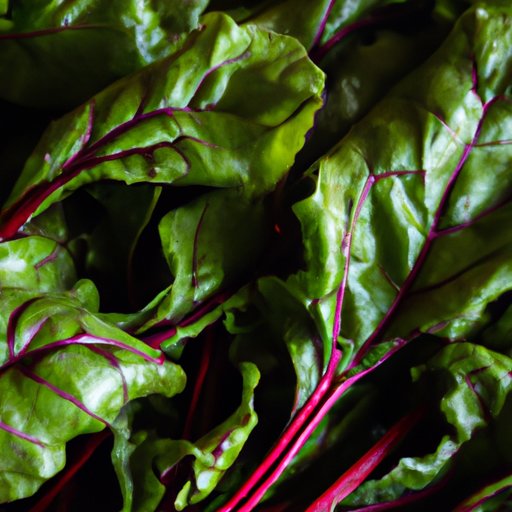
Introduction
Beets are often enjoyed as a colorful root vegetable, but did you know that the beet leaves, or greens, are also edible and highly nutritious? Unfortunately, beet greens are often overlooked as a food source. In this article, we’ll explore the nutritional value of beet leaves, their culinary uses, and the health benefits they offer. We’ll also address common concerns about consuming beet leaves, provide tips for harvesting and preparing them, and offer 10 delicious recipe ideas to try.
The Nutritional Value of Beet Leaves: Why You Should Add Them to Your Diet
Beet leaves are a rich source of vitamins A, K, and C, as well as minerals like calcium and iron. In fact, they contain even more iron and calcium than spinach! Compared to other leafy greens like kale and Swiss chard, beet leaves are also relatively low in oxalates, which can interfere with nutrient absorption.
Eating beet leaves has been linked to several health benefits, including improved digestion, lowered blood pressure, and reduced inflammation. They may also help protect against certain forms of cancer and contribute to healthy brain function.
Beyond the Beetroot: Exploring the Versatility of Beet Greens in the Kitchen
Beet leaves have a slightly bitter and earthy taste that pairs well with both sweet and savory flavors. They also have a tender, delicate texture that makes them a great addition to salads, stir-frys, and soups. In Mediterranean and Middle Eastern cuisine, beet leaves are often stuffed with rice and herbs and served as a delicious appetizer.
To use beet leaves in your cooking, simply wash them thoroughly and remove any tough stems. They can be eaten raw or cooked and are a great substitute for other greens like spinach and kale.
Are Beet Leaves Safe to Eat? Your Essential Guide
One concern with beet leaves is the potential for contaminants, such as pesticides. To avoid this, look for organic beet leaves or grow your own. If you do purchase beet leaves, be sure to wash them thoroughly to remove any dirt or debris.
Another concern is the high level of oxalic acid, which can cause kidney stones in some individuals. However, the amount of oxalic acid in beet leaves is relatively low compared to other leafy greens, so it should not be a concern for most people. If you have a history of kidney stones, it’s best to talk to your doctor before consuming beet leaves.
From Garden to Plate: How to Harvest and Prepare Fresh Beet Leaves
To harvest beet leaves from the garden, simply cut the leaves off at the base of the stem, leaving the root intact. The leaves can be used immediately or stored in the refrigerator in a plastic bag for up to a week.
To prepare beet leaves for consumption, wash them thoroughly and remove any tough stems. They can be eaten raw or cooked and are a great substitute for other greens like spinach and kale. Beet leaves can also be blanched, sautéed, or roasted for an even more delicious flavor.
Exploring the Health Benefits and Culinary Uses of Beetroot Leaves
In addition to beet leaves, beetroot leaves (the leaves attached to the root) are also edible and highly nutritious. They are a great source of fiber, antioxidants, and anti-inflammatory compounds. Consuming beetroot leaves has been linked to decreased risk of heart disease, improved liver function, and reduced chances of developing dementia.
To incorporate beetroot leaves into your meals, try adding them to smoothies, salads, or soups. They can also be used in place of other leafy greens in recipes like quiches, frittatas, and sandwiches.
10 Delicious and Easy-to-Make Recipes that Use Beet Greens
Looking for some inspiration on how to use beet greens in your cooking? Check out these 10 delicious and easy-to-make recipes:
- Beet Green Salad with Apples and Walnuts
- Beet Green Pesto
- Spicy Beet Green Stir-Fry
- Beet Green Frittata
- Beet Green and White Bean Soup
- Beet Green Chips
- Beet Green and Ricotta Stuffed Shells
- Beet Green and Goat Cheese Tart
- Grilled Beet Greens with Lemon and Garlic
- Beet Green and Quinoa Salad
These recipes showcase the versatility of beet greens and highlight their unique flavor and texture. They’re also simple enough for beginners to master and can be customized to suit your taste preferences.
Conclusion
Beet leaves and beetroot leaves are highly nutritious and versatile ingredients that can be easily incorporated into a variety of dishes. They offer a range of health benefits and are generally safe to consume, provided you take basic precautions like washing them thoroughly and sourcing them from a reputable source. We encourage you to try incorporating beet leaves into your diet, starting with the 10 delicious recipes we’ve included in this article.




